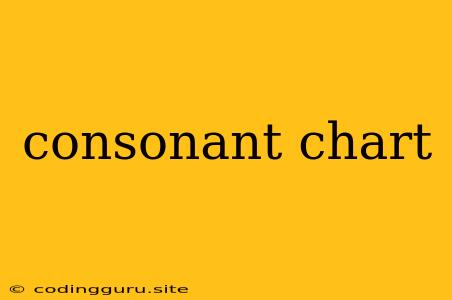The Consonant Chart: A Guide to Understanding Sounds
The consonant chart is an essential tool for anyone interested in learning about the sounds of a language. It visually organizes the consonants of a language, displaying them according to their place and manner of articulation. Understanding the consonant chart allows you to:
- Identify the sounds: See where a sound is made in your mouth and how it's produced.
- Pronounce words correctly: Learn how to pronounce words by understanding how the consonants are produced.
- Understand language relationships: Compare and contrast different language's consonant charts to explore how languages are related.
What is a Consonant Chart?
A consonant chart is a graphical representation of the consonants in a language, usually arranged by their place and manner of articulation.
- Place of articulation refers to the part of the mouth where the air stream is constricted or stopped. This could be the lips, teeth, alveolar ridge, hard palate, or velum.
- Manner of articulation describes how the air stream is modified during the production of the sound. This could be by stopping the airflow completely (stop), partially obstructing it (fricative), or causing a turbulent flow (affricate).
How to Read a Consonant Chart
The consonant chart is typically arranged in a grid with the following columns:
- Bilabial: Sounds produced by bringing both lips together (e.g., p, b, m).
- Labiodental: Sounds produced by the lower lip against the upper teeth (e.g., f, v).
- Dental: Sounds produced by the tip of the tongue against the upper teeth (e.g., θ, ð).
- Alveolar: Sounds produced by the tip of the tongue against the alveolar ridge (e.g., t, d, n, s, z, l, r).
- Post-alveolar: Sounds produced by the tongue blade against the area behind the alveolar ridge (e.g., ʃ, ʒ, tʃ, dʒ).
- Palatal: Sounds produced by the front of the tongue against the hard palate (e.g., j).
- Velar: Sounds produced by the back of the tongue against the soft palate or velum (e.g., k, g, ŋ).
- Glottal: Sounds produced by the vocal cords (e.g., h).
The rows of the consonant chart usually represent the manner of articulation:
- Stops: The airflow is completely stopped for a brief moment (e.g., p, b, t, d, k, g).
- Fricatives: The airflow is partially obstructed, creating a hissing or buzzing sound (e.g., f, v, θ, ð, s, z, ʃ, ʒ, h).
- Affricates: A combination of a stop and a fricative (e.g., tʃ, dʒ).
- Nasals: The airflow is directed through the nose (e.g., m, n, ŋ).
- Liquids: The airflow is partially obstructed, but the sound is more resonant than a fricative (e.g., l, r).
- Glides: These are similar to vowels, but the tongue moves quickly to a different position (e.g., j, w).
Examples of Consonant Charts
Different languages will have different consonant charts, as they have different sounds.
Here are some examples of consonant charts:
- English:
- Place of articulation: Bilabial, labiodental, dental, alveolar, post-alveolar, palatal, velar, glottal.
- Manner of articulation: Stops, fricatives, affricates, nasals, liquids, glides.
- Spanish:
- Place of articulation: Bilabial, labiodental, dental, alveolar, post-alveolar, palatal, velar, uvular.
- Manner of articulation: Stops, fricatives, affricates, nasals, liquids, glides.
- Japanese:
- Place of articulation: Bilabial, labiodental, alveolar, post-alveolar, palatal, velar.
- Manner of articulation: Stops, fricatives, nasals, liquids, glides.
Using the Consonant Chart for Language Learning
The consonant chart can be a valuable tool for language learners. By understanding the place and manner of articulation of consonants, learners can:
- Improve pronunciation: Learn to produce the sounds correctly.
- Identify differences between sounds: Distinguish between similar sounds, like t and d.
- Learn new sounds: Understand how to produce sounds that are not in their native language.
Conclusion
The consonant chart is a powerful tool for understanding the sounds of a language. It provides a visual representation of the consonants, making it easier to learn about their production and pronunciation. By using the consonant chart, language learners can improve their pronunciation, distinguish between similar sounds, and learn new sounds.
